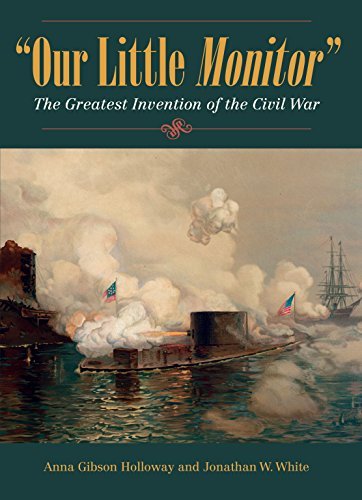“Our Little Monitor” The Greatest Invention of the Civil War
Anna Gibson Holloway & Jonathan W. White
 Few Civil War ships have been as written about as USS Monitor. Many books and articles about the first-of-its-kind warship and the Battle of Hampton Roads, which served as its proving ground have been published. This new work by Anna Gibson Holloway and Jonathan W. White is positioned to become the definitive work about Monitor. This should come as no surprise, as there may be no one in the field as knowledgeable about this ship as Dr. Holloway. As curator of the USS Monitor Center at the Mariner’s Museum in Newport News, Virginia, she became immersed in the history, archaeology, and lore of one of America’s most famous warships, first turning that knowledge into a doctoral dissertation, and then this book, which deserves a place on the shelf of everyone with an interest in the American Civil War. Here, the story of Monitor is told with great care and detail, without becoming mired in minutiae.
Few Civil War ships have been as written about as USS Monitor. Many books and articles about the first-of-its-kind warship and the Battle of Hampton Roads, which served as its proving ground have been published. This new work by Anna Gibson Holloway and Jonathan W. White is positioned to become the definitive work about Monitor. This should come as no surprise, as there may be no one in the field as knowledgeable about this ship as Dr. Holloway. As curator of the USS Monitor Center at the Mariner’s Museum in Newport News, Virginia, she became immersed in the history, archaeology, and lore of one of America’s most famous warships, first turning that knowledge into a doctoral dissertation, and then this book, which deserves a place on the shelf of everyone with an interest in the American Civil War. Here, the story of Monitor is told with great care and detail, without becoming mired in minutiae.
The book is divided into two parts. The first part, “The Monitor in History and Memory” details the history of Monitor from conception to demise to ultimate discovery and recovery. The opening chapter begins the story by discussing the standing of both the Union and Confederate navies at the outbreak of war and the conversion of USS Merrimack to CSS Virginia by the Confederates. From this starting point, the authors examine the politics of the Union Navy as its officers and other government officials debated building armored warships, until finally contracts were let for building Monitor and others. Chapters 3 and 4 cover the building of Monitor and the Battle of Hampton Roads.
Chapters 5, 6, and 7 are quite possibly the most interesting in the book. Chapter 5 looks at Monitor in popular culture, beginning immediately following the battle. Songs and poems were written about the ship, many consumer items were produced using images of the ship and the battle, and national interest soared. Images of the ship continued to be used in advertising well into the twentieth century. Chapter 6 explores the thoughts of people across the spectrum immediately following the battle. While many in the country were ecstatic about this new era of naval history, the officers and sailors often viewed things differently. Though widely touted as heroes, many of the men on board did not agree. Some felt as though they had not even been in a battle, one officer stating, “we haven’t done much fighting, merely drilling the men at the guns a little.” Another wrote to his wife, “there isn’t even danger enough to give us any glory.” In 1866, Herman Melville wrote in a poem about the ship, “War shall yet be, but warriors/Are now but operatives.” These sentiments ring true today, as modern warfare has brought us to the point where drones can do much of the fighting and killing. Chapter 7 tells the story of the last two months of Monitor’s life, ending in the ship’s loss off Cape Hatteras, the details of which are still chilling today.
The final chapter of the first part of the book conveys a very detailed account of the search for and discovery of the wreck, as well as the recovery of the engines and turret. The authors also discuss the attempt to identify the remains of two sailors found in the turret, and their eventual interment at Arlington National Cemetery, which provides a fitting ending to the story.
The second part of the book is a collection of original documents related to the Monitor, each with added context. Some are letters written about the ship or life on board; others are articles from a variety of newspapers nationwide. There are stunning, full color photographs of designs for other types of ironclads, improvements to Monitor, and other various and sundry inventions that were sent to President Lincoln. This portion of the book is not only interesting to read, but also a good reference.
The Kent State University Press did a marvelous job producing this book. The pages are glossy like a textbook, but of heavier stock. The full color illustrations throughout bring the book to life. Aside from the Mariner’s Museum collections, material from the Library of Congress, National Archives, and NOAA are used extensively. The quality of this volume is impressive. The research is excellent, the bibliography is solid, and the writing is fluid. Highly recommended!
- Kent: The Kent State University Press, 2018
- 7-1/4” x 10-1/2”, hardcover, xix +283 pages
- Illustrations, tables, appendix, notes, bibliography, index. $34.95
- ISBN: 9781606353141
Reviewed by Andrew Duppstadt, North Carolina Division of State Historic Sites
